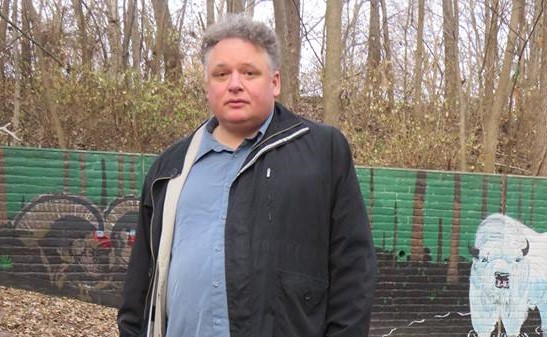Opinion: 'The Aristocrats' -- how Rachel Notley just drove another nail into Horatio Alger's coffin
By Stuart Parker
As Hunter S. Thompson began to observe the failure of the 1960s and the rise of modern neoliberal capitalist retrenchment, he increasingly referenced Horatio Alger stories of the First Gilded Age to describe his own precarious position in a resurgent decadent American capitalist plutocracy. Las Vegas in the 1970s was “the American dream in action” because the randomness and decadence of pre-1929 American capitalism had returned, that magical two-generation period of unfettered cultural and material capitalism from 1876-1929, named “the Gilded Age” by Mark Twain.
Las Vegas was the perfect representation of the world that ended with the stock market crash of 1929, in which stock speculation, installment plans, commodity rushes and the ideologically-motivated Ponzi schemes of the KKK and Marcus Garvey’s UNIA had turned all of America into the interior of a mobbed-up casino.
When Mitt Romney’s Bain Capital and the Trump Organization made money for its own sake a legitimate ideology again in Ronald Reagan’s America, there was a celebration of the randomness and chance of turning America back into an enormous, brightly-lit casino. The two tropes of an Algeresque story were brought back: (1) the big break for the little guy and (2) the courageous investor who takes a risk on said little guy and his idea.
In the brutal world of Gilded Age capitalism, it was a self-evident truth that most hard-working people would die, forgotten, in poverty. Hard work was not a passport to wealth but instead, the human condition of the working class. To strike it rich, to make it big, to ascend from the working class to join the great robber barons required two ingredients: exceptional courage and exceptional luck. An exceptionally courageous worker would try to get near his bosses, show how exceptional he was, take risks by switching jobs, patenting a new product, defying his manager, etc. (Yes, these guys were all men.)
But, by themselves, courage and hard work were necessary but not sufficient conditions to ascend to the ranks of the Morgans and the Hearsts. Luck had to intervene. It was placing one’s future in the hands of fate that was the act of courage, to bet that some piece of good and improbable fortune would intervene to make one’s aspirations flesh, a chance encounter with the boss, rescuing an apparent orphan who turned out to be a kidnapped child of the super-rich, being polite to a young woman who turned out to be the boss’s daughter, etc. Whether one celebrated capitalism like Alger or deplored it like Charles Dickens, the Gilded Age novel pivoted on the Big Break, the invisible hand of fate resting randomly on the novel’s protagonist.
Secondary to this, in fiction, was the fact that a great man, a capitalist who was already rich and powerful, would risk some portion of his great fortune by trusting this young and unaccomplished man. Instead of resting on his laurels, he would speculate bigger, further, more ambitiously, proving his worthiness as one of the oligarchs of Gilded Age capitalism.
Millionaires who ceased speculating, ceased taking risks, ceased engaging with chance, i.e. those who tried to leave the great American casino with their winnings, were not legitimate members of the oligarchy and would ultimately be displaced by less risk-averse, hungrier men.
In this way, Gilded Age capitalism was affixed to a theory of masculinity, a theory that allowed old, fat, comfortable men to continue to show their vigorous masculinity through risk taking by placing big, dangerous bets in the casino of life.
This was the idea that Reagan-era men like Donald Trump and Mitt Romney used to legitimate their continued right to the family fortune. By taking newer, bigger risks with the family money, they could show that their legitimacy was not based on a theory of hereditary aristocracy but instead a practice of masculine risk-taking.
During the Great Recession of 2007-09, that discourse was abandoned by the American political imaginary: speculation, risk-taking and the possibility of loss were abandoned as legitimating discourses by the super-rich. Only suckers took risks, black people with underwater mortgages in Cleveland were chumps who took actual risks with their meager resources. Rich, powerful people, the story went, were entitled to a sure thing.
TARP, the Troubled Asset Relief Program, and its equivalents around the industrial West were based on the opposing theory of the legitimacy of capital: “too big to fail.” While people with small amounts of money had to face real consequences for speculating, the oligarchs were guaranteed economic certainty. In this way, while capitalism has always been governed by inherited wealth, it went from effacing this truth to celebrating it. Instead of arguing that the super-rich deserved their money because they took risks, it was argued that because the super-rich deserved their money, they had to be immune from risk.
This week, in my province, two things have happened that are perfectly illustrative of this new reality. The office of my member of the legislature, David Eby, was again besieged by protesters furious that $89 billion have been drained out of Vancouver’s real estate market since the government began taxing people who have a second, vacant home in places where there is a housing crisis and began to investigate and prosecute the use of the real estate market for money laundering by international organized crime and drug syndicates.
The reason they are protesting is that they believe that capitalism guarantees them the certainty that things they buy will appreciate and the state’s job is to make sure that happens. In their view, the introduction of risk is an affront to their idea of a fair marketplace. In a fair economy, anyone with sufficient wealth has the right to see their investments appreciate and those with an insufficient amount experience risk. Some people say that these individuals are fighting for their right to make money by speculating but the reverse is true. What offends these people is that they are being required to speculate, to take chances, in order to get richer. Unlike the first Gilded Age, such a requirement is not the justification for capitalism but instead an affront to the late capitalist moral order.
Today, Rachel Notley, the leader of the opposition in the province of Alberta commended the BC Court of Appeal for “creating investor certainty” for oil companies by prohibiting any environmental regulation of a gigantic bitumen pipeline being forced through BC to the Pacific Coast. The Alberta NDP, a Third Way party, sees itself as servants of the investor class and understands the job of both the legislative and judicial branches of the state as having the primary role of insulating Exxon, Suncor, Royal Dutch Shell and their ilk from market forces, insuring that whatever money they invest is not speculation but is, instead, a sure thing.
While ordinary decent people cry out against this kind of monstrous thinking, the entire political class of North America has embraced what is essentially, an aristocratic reimagining of capitalism as its own opposite. Back in the Gilded Age, Friedrich Engels, Karl Marx and Vladimir Lenin admired capitalism’s churn, its incorporation of risk as a means to revolutionize itself. We have now reached a very different stage of capitalism: a system in which an insulated, plutocratic elite stumbles around drinking its own bathwater.
George W Bush, Donald Trump and Justin Trudeau all inherited their jobs because capitalism is losing its primary dynamic character. Because the whole system is rigged, we are producing leaders like Commodus and Charles VII. Alger’s hero is dead, slain by bloodless technocrats like Notley, who believe that it is their job to “creat[e] investor certainty,” to be the Cardinal Richelieu to our modern Louis XIII’s, to insulate our modern aristocrats from risk or consequence.
























